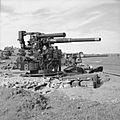V-1 flying bomb facts for kids
Quick facts for kids V-1 flying bombFieseler Fi 103 Flakzielgerät 76 (FZG-76) |
|
|---|---|
 |
|
| Type | Guided missile |
| Place of origin | Nazi Germany |
| Service history | |
| In service | 1944–1945 |
| Used by | Luftwaffe |
| Wars | World War II |
| Production history | |
| Designer | Robert Lusser |
| Manufacturer | Fieseler |
| Unit cost | 5,090 RM |
| Specifications | |
| Mass | 2,150 kg (4,740 lb) |
| Length | 8.32 m (27.3 ft) |
| Width | 5.37 m (17.6 ft) |
| Height | 1.42 m (4 ft 8 in) |
|
|
|
| Warhead | Amatol-39 |
| Warhead weight | 850 kg (1,870 lb) |
|
|
|
| Engine | Argus As 109-014 Pulse jet engine |
|
Operational
range |
250 km (160 mi) |
| Maximum speed | 640 km/h (400 mph) flying between 600 to 900 m (2,000 to 3,000 ft) |
|
Guidance
system |
Gyrocompass based autopilot |
The V-1 flying bomb was a special weapon used during World War II. People also called it the Buzz Bomb or Doodlebug. It was an early type of cruise missile, which is like a small, unmanned airplane packed with explosives.
The V-1 had a jet engine that made it fly very fast. It could travel at about 600 kilometers per hour (350 miles per hour). The German air force, called the Luftwaffe, aimed these bombs at cities. They mostly targeted London in the United Kingdom and Antwerp in Belgium.
These bombs caused a lot of damage. They destroyed almost as many houses as the earlier "Blitz" bombing campaign. Sadly, 22,892 people lost their lives because of V-1 attacks.
The Allies worked hard to stop these attacks. They bombed the places where the V-1s were launched. They also shot at the bombs in the air. Sometimes, brave pilots would fly their fast planes very close to a V-1. They would then use their plane's wing to gently push the V-1 off course. This made the bomb crash harmlessly.
How the V-1 Worked
The V-1 had a simple guidance system. This system helped it fly in the right direction. However, it was not very accurate.
Only about 25 out of every 100 V-1s actually hit their targets. Many were stopped by the Allies' defenses. Others failed because of mechanical problems or errors in their guidance system.
Related pages
Images for kids
-
Rear view of a V-1 at the Imperial War Museum Duxford, showing part of its launch ramp
-
A model of an Arado Ar 234 plane carrying a V-1 at the Technikmuseum Speyer
-
A group of large guns used to shoot down V-1s near Hastings, England, in July 1944
-
A V-1 and part of its launch ramp on display at the Imperial War Museum Duxford (2009)
-
A V-1 flying bomb on display at the Imperial War Museum London
-
A V-1 on display at the Air Zoo museum
See also
 In Spanish: Fieseler Fi 103 para niños
In Spanish: Fieseler Fi 103 para niños















